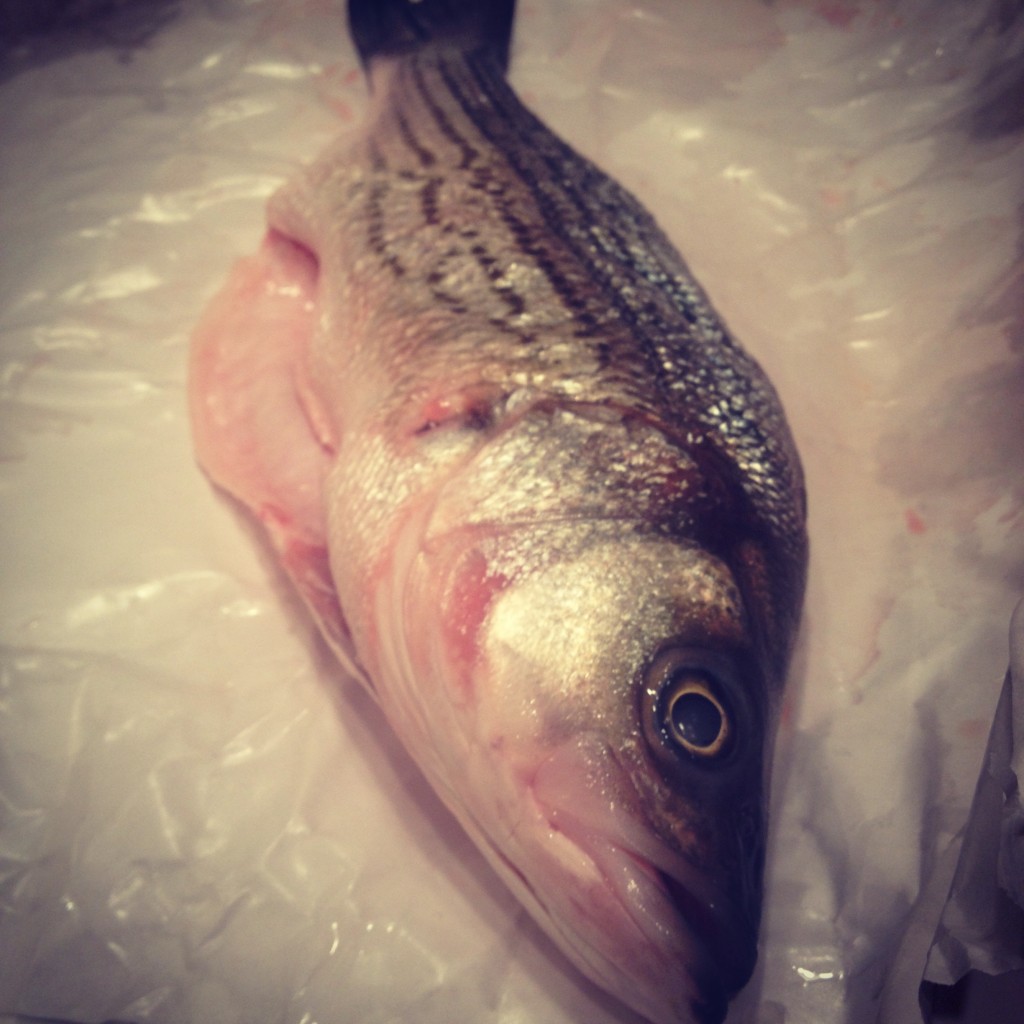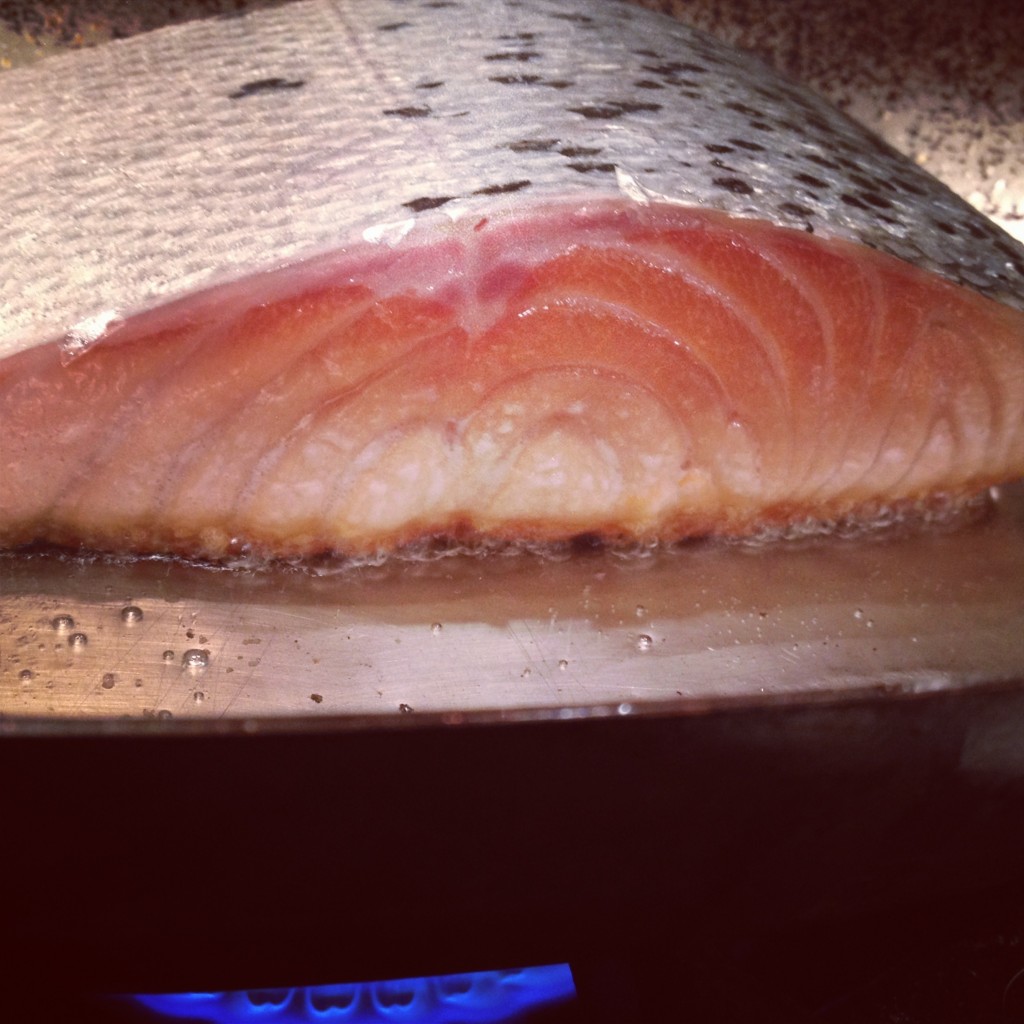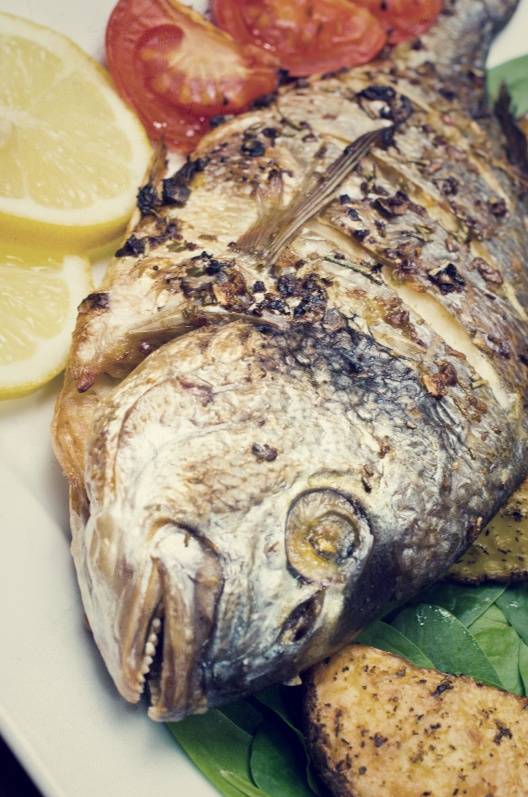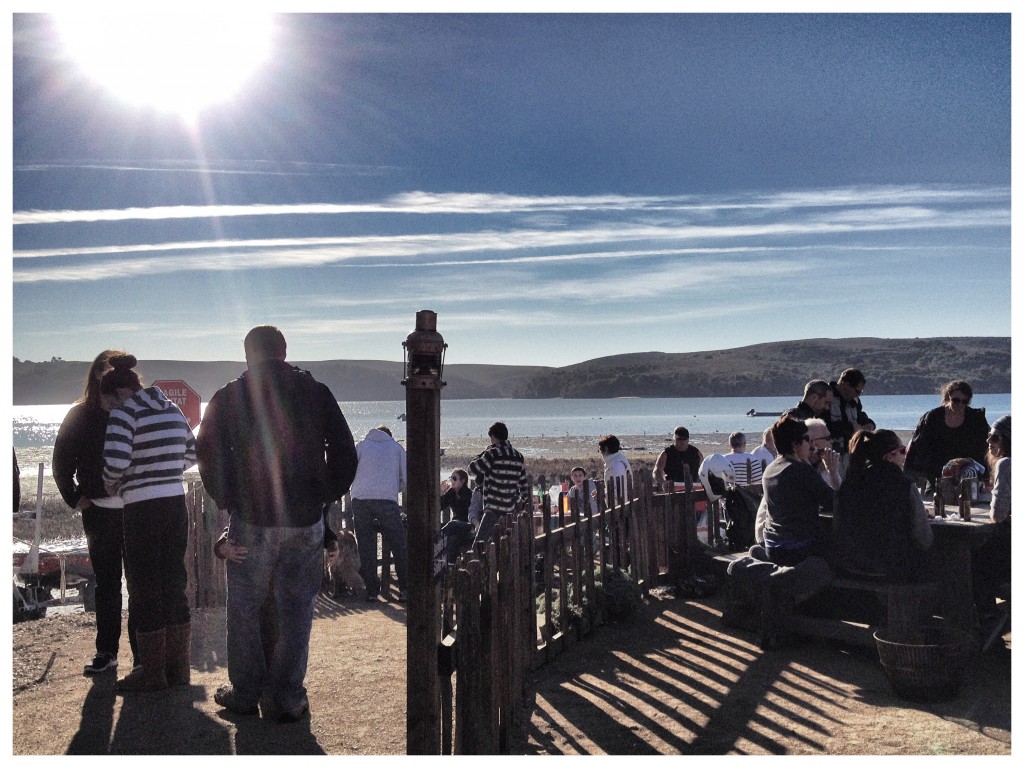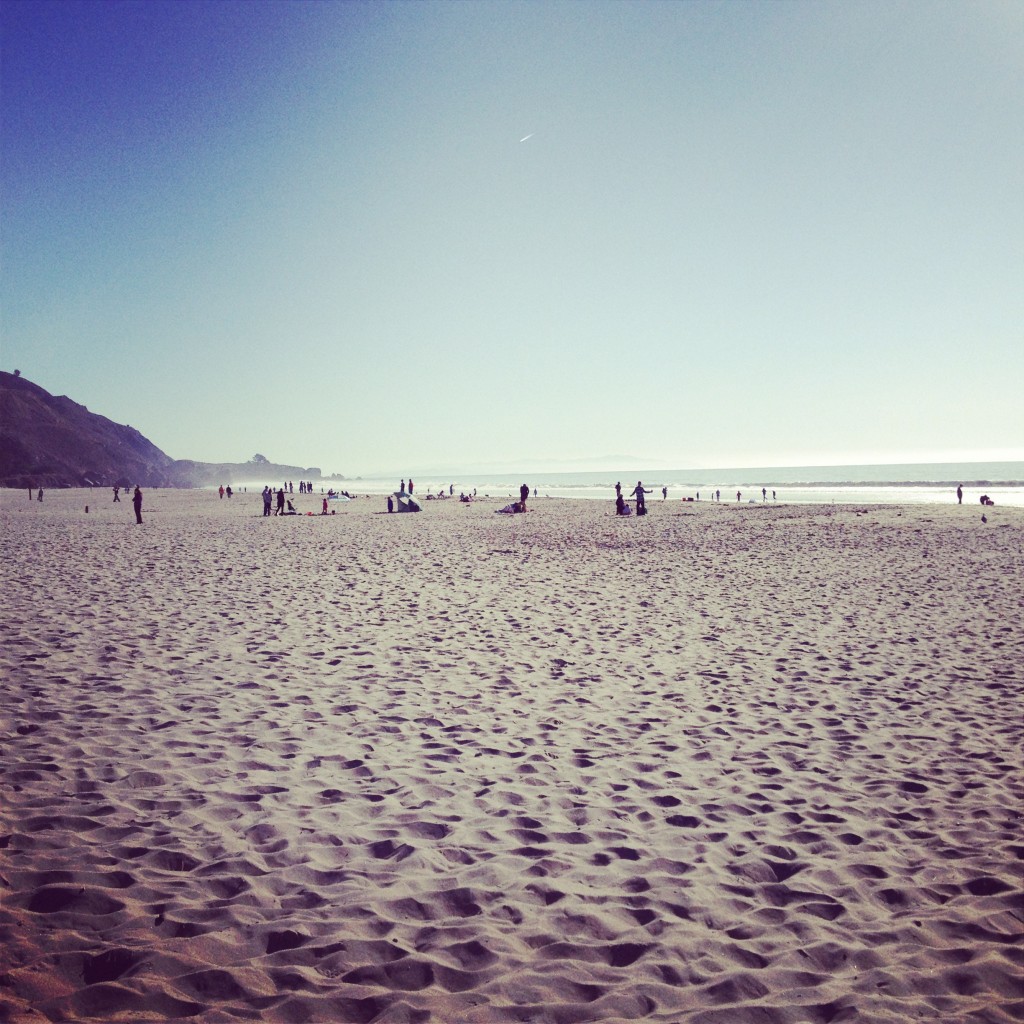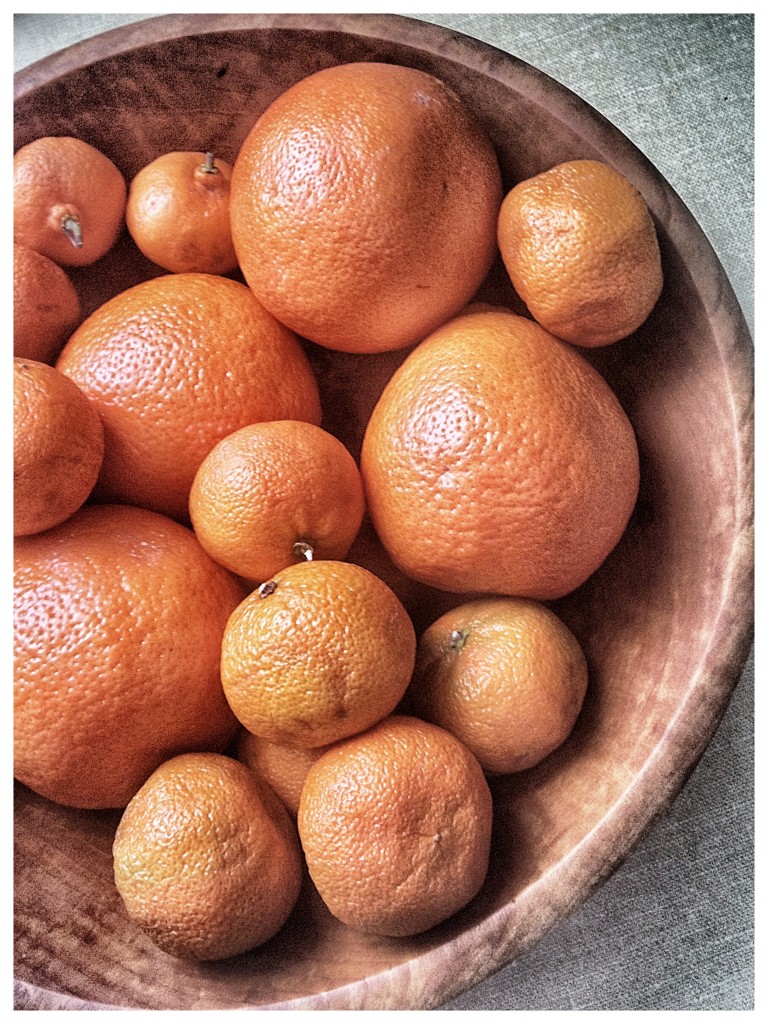(Note: this fish, above, is not a trout. It’s a striped bass, caught in the waters off Brooklyn.)
Many years ago, when I was living in New York, I had the distinction of being fed a special lunch by a local Thai restaurant on Ninth Avenue, the owners of which claimed to have a simple and healthy but still festive cure for the excesses of the holiday season that had just passed. The place was tiny and perpetually dank, and lit by two dangling pink-toned incandescent bulbs that cast a warm, slightly lewd pallor on food and patron alike. Convinced that their cure was exactly what I needed, I ordered it — the server called it trout crispy. What arrived was a whole fish of indeterminate species resting upright on its broad belly; its jaws had been pried open and stuffed with a dollop of jellied sterno which was then set ablaze with a match. Angry blue flames leapt out of its eye sockets and gills, and straight through the top of its little ginger and garlic-infused head. The dish, while in fact crispy, was neither festive nor healthy and as the flames grew more threatening, I had no choice but to extinguish them with a small glass of water, which sent small plumes of sesame-scented smoke into the soggy, mauve air.
I never went back.
But somehow, the act of eating fish — a lot of fish — in the earliest months of the new year took hold, and has stayed with me all this time; the older I get, the more it shows up on my table in the dead of winter. (I’m not sure whether or not that’s just a natural progression that accompanies age; by the time she was seventy-five, my grandmother was eating broiled fillet of sole three times a week, lightly dusted with paprika, but only in the winter. She also had a stash of stolen Sweet n Low packets living in the zippered compartment of her purse, along with sucking candies wearing jackets of fuzz. I’m not there. Yet.) Most people like dark and murky stews this time of year; I want pan-seared mackerel with a squeeze of lemon, or a dribble of bright chermoula. While meat makes me feel warm and cozy during the winter, fish makes me feel less, well, thick.
Almost every morning on my way to work this time of year, bundled up to the eyeballs under layers of down and fleece, I walk through Grand Central Station’s food stalls and find myself stopping not at the meat concession — which purveys some of the best beef, pork, and lamb in the city — but at two (not one) fishmongers, to see what’s come in earlier that morning. I’ve got it figured out: one of the mongers has spectacular head-on prawns and sardines but their salmon always looks a little peaked. Their halibut is fabulous as is their Black Sea Bass (my favorite fish of the moment), but the price difference between the fillets of the latter and the whole fish is an utterly insane $16.00 a pound versus $6.99 a pound (buy whole fish, as a rule, except for shad which is a filleting nightmare, and learn how to fillet it yourself). Their stall is often so busy that when you buy one thing, you’ll take it home to discover it’s something else entirely: I once bought my beloved Black Sea Bass and spent my two hour commute dreaming of how I was going to prepare it. I got home, took my coat off, and unwrapped it only to discover they had given me Vietnamese Basa (also known as Swai, which is a kind of catfish) by mistake. You couldn’t possibly find two more different fish than Black Sea Bass and Vietnamese Basa, both in consistency and price; it would be like comparing filet mignon to beef shin.
The other stall, I discovered, is much better for hyper-local stuff — stripers that come in off the boats from Sheepshead Bay in Brooklyn, more Black Sea Bass, even Scup and Croaker — which, with the exception of wild salmon, mackerel, and sardines, is what I’m trying hard to buy exclusively. Everyone talks about the glories of local food, how great it is for us, the environment, the animals, the farmers — and it absolutely is — but it’s so easy to forget it when you’re talking about seafood; it’s almost like it doesn’t count if we can’t see it, if its living its life submerged rather than marching around a pasture munching on grass. Many winters ago, Susan and I went out for dinner in Washington, DC with my cousins, who took us to a truly fabulous fish house; we all ordered fancy-ish monster fish — the giant predators: tuna, swordfish, halibut — and Susan asked what the special was. The server tried to steer her away from it. Susan persisted.
It’s local, from Virginia waters, he said, sort of rolling his eyes and pushing her towards the swordfish. She cut him off mid sentence; her Red Drum arrived, lightly dredged in flour, pan-fried with a squeeze of lemon. We all took a bite and sighed; she had the winner. It was fresh, light, and sweet, and smelled like the sea.
It might have been the emotional distress caused by having to extinguish trout crispy all those years ago, but no matter what I do, I can’t help but prepare my fish simply; I mean, why would you take anything fresh and delicately-flavored and render it gastronomically indecipherable? It makes no sense, unless the fish is off (and then you wouldn’t want to go near it at all). My favorite methods of cooking fish take no time: if you’ve got fillets, dredge them in flour (I’m liking rice flour these days, not only because I’m gluten-free but because the result is super crispy and light) and pan-fry them in a little very hot neutral oil or ghee, or if you’re dealing with whole fish, slash the skin right down to the bone in a few places and massage them with an herb paste inside and out, and broil it on both sides for about 5 minutes each, until the skin is blistered a deep golden and pocked with char.
But perhaps, the best method of all comes from Peter Kaminsky — fish-fanatic extraordinaire and one of the very best writers (on any subject) I know — by-way-of-Laurent Gras. In Peter’s great book, Culinary Intelligence — in which he derides the act of joyless, pleasureless dieting in the name of health (where food is treated as the enemy, to be beaten into submission) in favor of re-learning how to eat smaller quantities of fresh (real) food packed with flavor — Peter describes Laurent’s simple method which involves little more than taking a pound and a half of firm, white-fleshed fish such as cod, striped bass, halibut, or redfish, and searing it in a hot, olive oil-slicked pan. You add some fennel seeds, lemon wedges, and unpeeled garlic cloves; a bit of salt and pepper; and a drizzle of more olive oil. The pan gets tipped and the hot oil spooned over the fish, which then, pan and all, gets popped into a 325 degree F oven to roast for 6 to 8 minutes. The fillets are served with the lemon wedges and garlic alongside, and drizzled with the pan-liquid. I have made this dish countless times — I prefer it with striped bass fillets — and every single time I am astonished at how wonderful and easy it is.
It’s so easy to be fearful of fish — there are mercury issues to contend with, and PCBs, and they say if you’re pregnant you really need to be careful — but frankly, it’s easy to be fearful of everything we eat, which seems to me utterly ridiculous and to blame for so many of our food woes. I may admittedly eat it a little bit more of it than I should — when I’m on a tear I eat fish as often as three times a week — but I figure that just as long as it’s not spewing blue flames out of its eyes and gills, I’m fairly safe.
